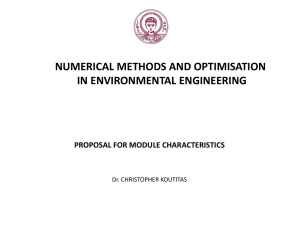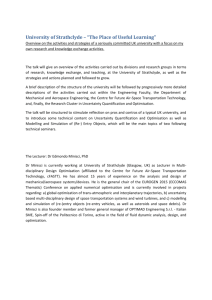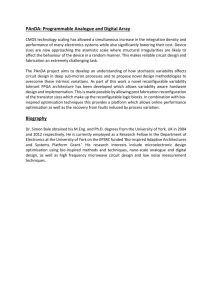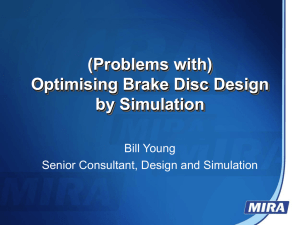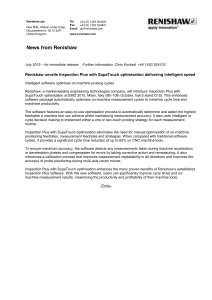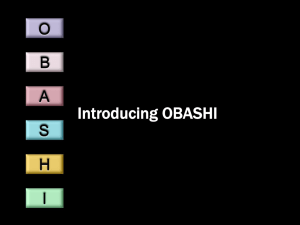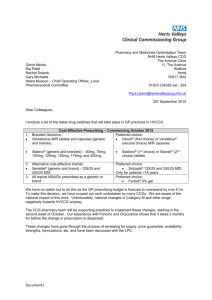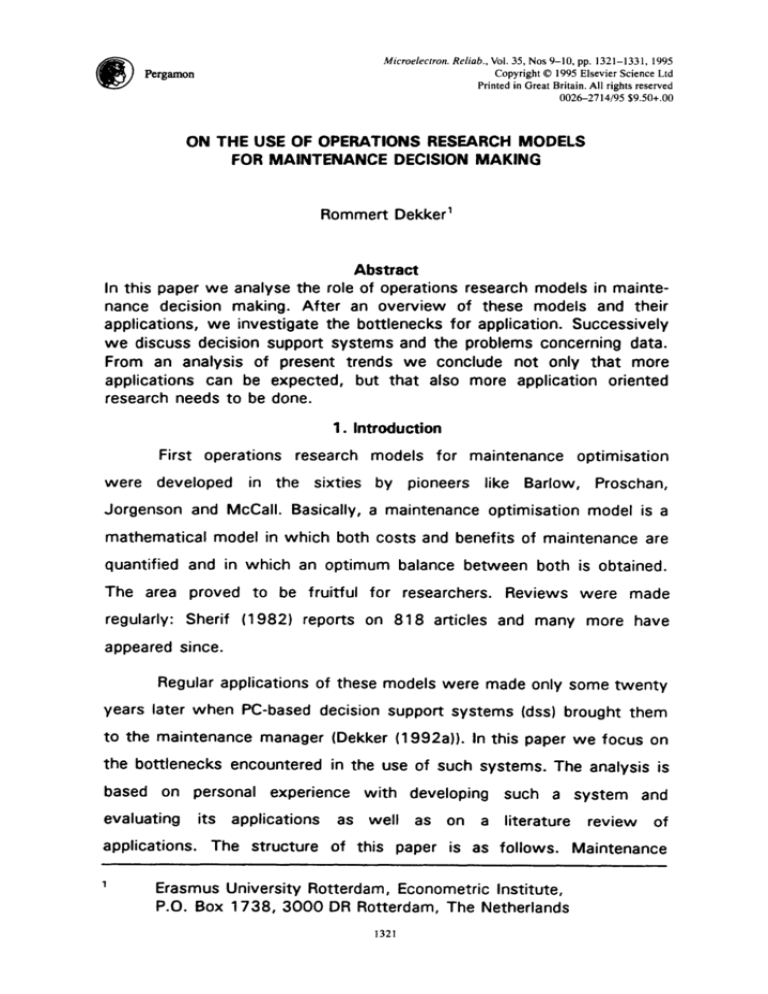
Microelectron. Reliab., Vol. 35, Nos 9-10, pp. 1321-1331, 1995
Copyright © 1995 Elsevier Science Ltd
Printed in Great Britain. All rights reserved
0026-2714/95 $9.50+.00
Pergamon
ON THE USE OF OPERATIONS RESEARCH MODELS
FOR MAINTENANCE DECISION MAKING
Rommert Dekker 1
Abstract
In this paper we analyse the role of operations research models in maintenance decision making. After an overview of these models and their
applications, we investigate the bottlenecks for application. Successively
we discuss decision support systems and the problems concerning data.
From an analysis of present trends we conclude not only that more
applications can be expected, but that also more application oriented
research needs to be done.
1. Introduction
First operations research models for maintenance optimisation
were
developed
in the
sixties by pioneers
like Barlow,
Proschan,
Jorgenson and McCall. Basically, a maintenance optimisation model is a
mathematical model in which both costs and benefits of maintenance are
quantified and in which an optimum balance between both is obtained.
The area proved to be fruitful for researchers. Reviews were made
regularly: Sherif (1982) reports on 818 articles and many more have
appeared since.
Regular applications of these models were made only some twenty
years later when PC-based decision support systems (dss) brought them
to the maintenance manager (Dekker (1992a)). In this paper we focus on
the bottlenecks encountered in the use of such systems. The analysis is
based on personal experience with developing
evaluating
its
applications
as well
as on
such a system and
a literature
review
of
applications. The structure of this paper is as follows. Maintenance
Erasmus University Rotterdam, Econometric Institute,
P.O. Box 1738, 3000 DR Rotterdam, The Netherlands
1321
1322
R. Dekker
optimisation models are introduced in section 2. In section 3 we present
a review of applications and discuss decison support systems in section
4. Section 5 deals with data problems. Finally, future prospects and
conclusions are stated in sections 6 and 7.
2. Maintenance optimisation models
In general, maintenance optimisation models cover four aspects: (i)
a description of a technical system, its function and its importance, (ii) a
modelling of the deterioration of the system in time and possible consequences for the system, (iii) a description of the available information
about the system and the actions open to management and (iv) an
objective function and an optimisation technique which helps in finding
the best balance. The results of these models are the following. First of
all, policies can be evaluated
and compared with
respect to
cost
effectiveness and reliability characteristics. E.g. a condition monitoring
policy can be compared with a planned preventive maintenance strategy.
Secondly, models can assist in the timing aspect: how often to inspect or
to maintain, e.g. once or twice a year. Finally, models can also be of help
in determining effective and efficient schedules and plans, taking all kind
of constraints into account.
3. Applications
3.1 An overview
Dekker (1992a) provides an overview of applications which have
been published in open literature. The total of 89 papers on applications
which were found may seem little, but only a small part of all applications
is likely to be published. Most case studies were written in cooperation
with academic reliability researchers (47 out of the 89). Few originate
from industry and if they do, often from an industrial research institute.
Consultants were badly represented, which gives the impression that,
Maintenance decision making
1323
until recently, application of maintenance optimisation models was only
possible by the people who developed them. This situation has changed
with
the
emergence
of
commercial
decision
support
systems
for
maintenance optimisation. What strikes is that many papers describe a
tailored-made model for the problem at hand. Apparently one often has to
include problem specific factors.
There are several areas and industries in which the models have
been applied; popular are equipment and vehicle replacements, inspection
optimisation, road maintenance and scheduling of maintenance of electric
power stations.
Equipment overhauls comprise the largest group of applications,
Another fruitful area is vehicle replacement, concerning buses, fork lift
trucks, ambulances etc. One advantage in case of vehicles, is that the
large number of units allows for data pooling. For equipment this is not
always possible as similar equipment in different conditions may have
quite
a different
failure
pattern.
A
third
and
promising
area
for
optimisation is road maintenance. Here, a main problem is the allocation
of budgets to various projects. The first successful case study was
presented in Golabi (1982) (he quoted savings of millions of dollars!).
Later quite some applications appeared in the US. Other countries
followed, including the Netherlands. One reason behind the successes in
this area, is that a lot of data is collected in standard ways on deterioration. Hence the need arises to make use of this data in decision making.
Furthermore, there is less time pressure on decision making compared to
other maintenance organisations, and as funds have to be allocated
between various projects in an objective and defendable way, there is a
need for objective methods, hence also for operations research models.
Related applications concern water resources infrastructure, pipelines and
railway track. A fourth application area concerns the scheduling of
1324
R. Dekker
electric power stations overhauls. The overview from Kralj and Petrovic
(1987) gives the impression that several operations research methods
have been applied.
The problems encountered in applying maintenance optimisation
models mentioned in the case studies frequently concern data collection
and analysis. As most papers advocate a technique, negative remarks on
maintenance optimisation are hard to find. An exception is Van Bommel
and Roes (1986), who describe a failure to apply standard models and
therefore (successfully) resort to failure analysis.
3.2 Software packages for maintenance optimisation
First packages for maintenance
optimisation were running
on
micro computers, like the HP 9845. They were developed by academics
with interest in practical applications.
Later, the personal computer
became a popular platform for development of maintenance optimisation
software.
A
successful
example
is
the
MAINOPT
package
(see
Woodhouse (1986)) in Europe; examples in the US are the AGE/CON,
PERDEC and
RELCODE packages,
all
including
analytical
models.
MAINOPT is in fact the first package which does not originate from
researchers, a fact which does show that theory has been picked up by
others.
3.3 Maintenance optimisation in the Netherlands
Although MAINOPT was developed in the UK, it also obtained
successes in the Netherlands, especially at Shell Pernis Refinery (see
Dekker et al. (1993)). In more than twenty projects it was used and the
savings run in the millions. The Koninklijke/ShelI-Laboratorium,
Amster-
dam has been active in developing decision support systems for Shell use
only. A simulation package was also developed at Eindhoven University
of Technology (see Both (1989), initially on a mini computer and later
Maintenance decision making
1325
converted to a PC, but it is not commercial. The KEMA has been active
and now supplies the KMOSS package, containing four different models
(Van Gestel (1992)). The Dutch State Water Authority, RWS (Rijkswaterstaat) had a prototype decision support system developed for road
maintenance by Worms and Van Harten (1992). The FEL-TNO laboratory
developed a package for maintenance of civil structures, using Markov
decision models (see Hontelez (1992)). Finally, the Delft Hydraulics
Laboratory did some cases on maintenance optimisation for the RWS as
well. Almost all packages deal with strategic maintenance problems.
4. Decision support systems for maintenance optimisation
It will be obvious that academics and some consultants have the
knowledge to apply maintenance optimisation models. Yet not many
applications
will
come off the ground,
unless the
knowledge
and
technology needed to do applications can be transferred to a maintenance
engineer. It is here that information technology plays an important role.
We will analyse what role it plays and distinguish four aspects.
(i) computers are necessary to do the calculations
Almost no maintenance optimisation model yields results which require
hand calculations
only.
Except for some specific
cases for which
graphical methods have been developed or explicit solutions exist, one
has to apply numerical integration or to solve sets of equations to
determine the optimal policy. In most cases PC's can do the job. The
main bottleneck lies in a userfriendly interface. The PC is and presumably
will remain the right platform, certainly for the next decade. The interface
with maintenance management information systems is not crucial, as
optimisation models tend to use other data than is stored in these
systems (see also section 5). Only if optimisation routines are used for
regular scheduling, a link is necessary.
1326
R. Dekker
(ii) the importance of user interfaces and userfriendly computer systems
Although it is not that difficult to write a software program for many of
the optimisation models, it is very difficult to have it used by others to
solve their problems. Just combining a number of models, algorithms and
a graphical interface into a program is not sufficient. Models are, by
definition, abstractions and simplifications from reality. If problems are
repetitive, such as in road maintenance, one has the time to find the right
model, if they are nonrepetitive, a dss should guide the maintenance
engineer in the modelling, allowing various options.
because this may coilfuse
him or her.
Hence
Not too many
a general
problem
structuring should be made on forehand which should fit on the bulk of
the problems. That is what developing a dss for maintenance optimisation
makes time consuming and therefore costly. A problem in this respect is
that concepts like failure, repair can have several interpretations, and it is
important to state and explain the assumptions used in the models.
People will only use software packages if they can easily communicate
with them and understand what they are doing (in the end they should be
able to convince their managers of the results). This asks for very friendly
userinterfaces,
in which data can be provided in the way they are
available to the user and in which results can be shown in the way the
user wants. Today, there is no package on the market which really meets
all these requirements. Finally, there is always a learning step in using
software systems. If they are not regularly used, there is a serious danger
that the experience needed to run them, fades away, with the result that
they are put aside. Courses are often provided with packages, but in
practice this has shown to be insufficient.
(iii) there is a lack of general modelling knowledge
There is a large variety of systems requiring maintenance and although
numerous models have been published, there is insufficient knowledge
about how standard models can be used for a given problem. Building a
Maintenancedecision making
1327
dss for each company is still costly, so it is important to know which
models are suited for which problems. Models for civil structures, like
roads, dams and buildings, tend to be driven by norms for functioning,
rather than by costs of nonfunctioning. This makes them different from
models for production equipment. More research needs to be done to
arrive at a set of standard models for a number of well-described problem
areas. A first attempt is given in Dekker (1992b).
(iv) the use of decision support systems in any organisation requires a
change of culture
Such a change
is difficult to achieve especially in a maintenance
organisation, as it is that focused on technical problem solving under time
constraints.
Maintenance
management
has to
accept
and
demand
quantitative methods as basis for decision making. They will only do so, if
they
have confidence
in them.
A focal point
in the maintenance
organisation, familiar with operations research and computers, can be
vital for the success of decision support systems. However, one should
realise that use of quantitative techniques is not synonymous with taking
the right decisions. Technical knowledge will remain very important.
5. Data
An essential part of a maintenance optimisation model is the
modelling of the deterioration and the occurrence of failures of a system
in time. Maintenance actions will only be effective and efficient if they
specifically address the relevant deterioration and failure mechanisms.
Global statistics, like an average failure rate, are therefore inappropriate
for most maintenance actions. Analysing data without knowing the
underlying failure mechanisms can lead to totally wrong results (consider
e.g. failures caused by wearout and by mal operation). This is often
aggrevated by an inadequate system-component structuring which is
used in maintenance reporting and the fact that malfunctioning of one
1328
R. Dekker
part may induce failures in others. Maintenance information systems thus
mainly store accounting
information on events and there is a wide
concern about the value of their data for engineering decision making.
Data should be collected under strict rules, defining components, failure
and individual maintenance actions accurately. As this requires a lot of
effort, one should concentrate on the most relevant areas. Identifying
these is also a complex problem. Exceptions are the condition monitoring
programs, for which usually dedicated manpower is available.
An alternative to statistical data analysis, is to elicit information on
failure distributions from maintenance technicians. Although it is far more
flexible, it is not easy either and may seem subjective; a formal method to
overcome this is given in Van Noortwijk et al. (1992). One should realise
that under good maintenance practices there are little failures. If failures
occur repeatedly, one may either change the system design or its
operation to prevent failures, with the result that data collection has to
start again. Other changes to systems have the same effect.
Apart from problems with deterioration and failure data, one also
has problems with cost data, especially with the indirect costs. It is easy
to calculate direct maintenance costs, but far more difficult to quantify
the benefits of maintenance. In case of maintenance for production equipment one has to value the increase in reliability, availability or efficiency.
The latter may be the easiest to judge. The first two are more difficult,
especially if the equipment bears a complex relation with the final
products
(e.g. one may use other equipment,
or equipment
is not
continuously needed). If maintenance benefits are for another department
than the one paying, one has even more problems. In cases where
extending system life is the maintenance objective (e.g. roads) one may
set norms or ask economists to do a specific calculation.
Maintenance decision making
1329
In all cases, decision support systems can help in reducing
uncertainty on data. By experimenting with different values one gets an
impression on the importance of data, which then helps in deciding
whether more time should be spend on getting better data.
6. Future prospects
Computers are becoming cheaper and more powerful. Moreover,
improvements in software technology allow faster and better software
development, with more intelligence embedded. Besides, it is widely
accepted that the amount of capital invested in technical systems will
continue growing. Due to increased demands on performance of these
systems (with respect to quality, reliability and safety), spending on
maintenance is likely to grow as well, a trend which is visible in many
companies. Contracting out maintenance further increases the need for a
higher quality of decision making. Maintenance optimisation models,
embedded
in
decision
support
systems
provide
an
objective
and
quantitative way of decision making. One which is defendable, and
therefore very-well suited for group decision making, especially since it
allows the evaluation of the economic consequences of decisions. As the
models constitute the only approach which combines reliability with
economics, they are in fact nothing more than extensions of the basic
economic methods to justify maintenance. In many cases it is not the
outcomes of the models which has most value, but the structuring of the
decision process, the reduction of uncertainty and the better insight into
of the effects of decisions across maintenance and production areas,
which yield most benefits.
7. Conclusions
The impact of maintenance optimisation on decision making within
maintenance organisations has been limited so far, but the few cases do
show that considerable cost savings can be obtained. As application tool
1330
R. Dekker
technology (both soft- and hardware) is only recently available against
reasonable costs and is rapidly developing, we expect that the future will
see much more maintenance decision support systems incorporating
optimisation models, though several hurdles still need to be taken.
Acknowledgement
The author would like to acknowledge various people, especially
Adriaan Smit and Cyp van Rijn from the Koninklijke/ShelI-Laboratorium,
Amsterdam for their contribution to the analysis reported in this paper.
References
Both, H. (1989), "Maintenance and Failure Behaviour of Technical
Systems: Design and Applications of a Simulation Model", Ph.D. thesis,
(in Dutch), Univ. of Eindhoven, NL
Dekker, R., (1992a), "Applications of Maintenance Optimisation Models:
a Review and Analysis", Report Econometric Inst. 9228/A, Erasmus
University Rotterdam.
Dekker, R., (1992b), "A General Framework for Optimisation, Priority
Setting, Planning and Combining Maintenance Activities", Report
Econometric Inst. 9270/A, Erasmus Univ. Rotterdam.
Dekker, R., Smit, A.C.J.M. and Van Rijn, C.F.H., (1993), "Maintenance
Optimisation Models and their Application in Practice" (in Dutch), Doelm.
Bedrijfsv., 5, nr. 1, p.4-7.
Golabi, K., Kulkarni, R.B. and Way, G.B., (1982), "A Statewide Pavement
Management System", Interf. 12, p. 5-21.
Hontelez, J.A.M. (1992), "OPTIMON - User manual version 2" (in Dutch),
Report FEL-92-C273, FEL-TNO, Den Haag.
Kralj, B.L. and Petrovic, R., (1987), "Optimal Preventive Maintenance
Scheduling of Thermal Generating Units in Power Systems - A Survey of
Problem Formulations and Solution Methods", Eur. Journ. Oper. Res., 35,
p. 1-15.
Sherif, Y.S., (1982), "Reliability Analysis: Optimal Inspection and
Maintenance Schedules of Failing Systems", Micr. Electr. & Reliab. 22,
p.59-115.
Maintenance decision making
1331
Van Bommel P. and Roes, A.W., (1986), "What is OR doing between the
Tracks", in: Tilanus, C.B., de Gans, O.B. and Lenstra, J.K. (eds.),
"Quantitative Methods in Management: Case Studies of Failures and
Successes", Wiley, Chichester, UK.
Van Gestel, P.J., (1990), "KMOSS, a Maintenance Optimization Support
System", Proc. Scand. SRE Symposium, Studsvik, Sweden.
Van Noortwijk, J.M., Dekker, R., Cooke, R.M. and Mazzuchi, T.A.,
(1992), "Expert Judgment in Maintenance Optimization", IEEE Trans. on
Rel., 41, p. 427-432.
Worms, J. and Van Harten, A., (1992), "Model based Decision Support
for Planning of Road Maintenance", working paper Univ. of Twente,
(submitted for publication).
Woodhouse, J., (1986), "Relating Maintenance to Production and
Company Profits", 6th. Nat. Conf. on Comp. for Maint. Mgmt.
RR 35:9/10-I

